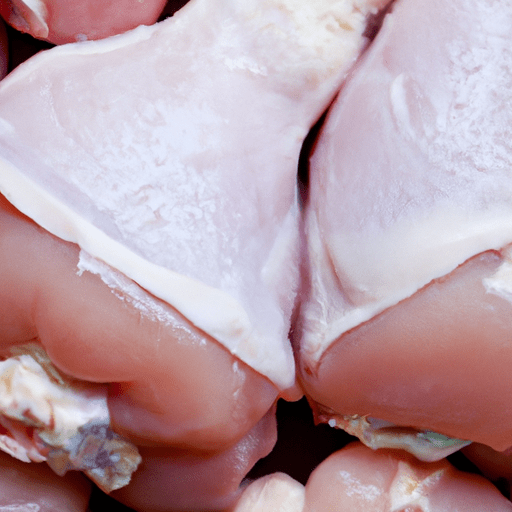Bone-In Chicken Breast Halves: A Versatile and Delicious Cut of Meat
If you’re a fan of tender and juicy chicken, bone-in chicken breast halves are an excellent choice. This cut of meat, known for its rich flavor and succulent texture, is a staple in many kitchens around the world. Whether you prefer grilling, roasting, or sautéing, bone-in chicken breast halves are incredibly versatile and can be prepared in a variety of creative ways.
Taste and Texture
Bone-in chicken breast halves have a distinct flavor that sets them apart from boneless cuts. The meat is tender and juicy, with a slightly darker color due to the presence of bones. The bone-in breast imparts a depth of flavor and moistness that enhances any dish it’s used in.
Common Uses in Cooking
Bone-in chicken breast halves lend themselves to a wide range of cooking techniques. Here are a few popular methods:
- Roasting: Seasoned with herbs and spices, bone-in chicken breast halves can be roasted to perfection, resulting in moist and flavorful meat. The bone helps retain juices and adds extra flavor during the cooking process.
- Grilling: Marinating bone-in chicken breast halves and grilling them over medium heat creates a delicious char on the outside while keeping the interior tender and juicy.
- Braising: Slowly simmering bone-in chicken breast halves in a flavorful liquid infuses the meat with rich flavors. This method is ideal for creating hearty and comforting dishes.
- Sautéing: Bone-in chicken breast halves can be quickly cooked in a skillet, producing a crispy skin and succulent meat. This method is great for adding chicken to pasta dishes, stir-fries, or salads.
Nutritional Value
Bone-in chicken breast halves offer a host of essential nutrients while being relatively low in fat. Here’s an overview of their nutritional value per 100 grams:
- Protein: 17.2 grams
- Fat: 2.9 grams
- Carbohydrates: 0 grams
- Calories: 107
They are also a good source of vitamins and minerals, including vitamin B6, vitamin B12, phosphorus, and selenium. With its high protein content and low calorie count, bone-in chicken breast halves make for a nutritious and satisfying meal.
History and Fun Facts
Chicken has been a part of human diets for centuries, with evidence of its consumption dating back to ancient times. The practice of domesticating chickens for food can be traced to ancient China and India, where people recognized the value of this versatile poultry.
Bone-in cuts, like chicken breast halves, have been favored by home cooks and professional chefs for centuries. The inclusion of bones in cooking provides not only flavor but also structural support and moisture retention.
Interestingly, bone-in chicken breast halves are often considered a healthier option than boneless cuts due to the presence of bones. The bones can act as a natural barrier, preventing excess fat and moisture loss during cooking, resulting in juicier and more flavorful meat.
Bone-in chicken breast halves deserve a place in every home cook’s repertoire. Their versatility, rich flavor, and nutritional benefits make them a go-to choice for many delicious recipes. Whether you roast, grill, sauté, or braise them, bone-in chicken breast halves are bound to elevate your culinary creations to new heights. So why not try incorporating this delectable cut of chicken into your next meal? Happy cooking!
Origin: Bone-in chicken breast halves are cuts of meat taken from the breast of a chicken. Chickens are domesticated birds that belong to the genus Gallus gallus domesticus, which is a subspecies of the red junglefowl. They are believed to have been domesticated around 4,000 to 10,000 years ago in Southeast Asia.
Common Uses: Bone-in chicken breast halves are versatile and can be used in various recipes and cooking methods. They can be roasted, baked, grilled, or sautéed. They are commonly used in dishes such as chicken cordon bleu, chicken piccata, and in traditional chicken soup recipes. Bone-in chicken breast halves can also be used to make chicken stock.
Nutritional Benefits: Bone-in chicken breast halves are a source of high-quality protein and are relatively low in fat compared to cuts of chicken with skin. They are also a good source of essential nutrients such as vitamins B6 and B12, niacin, phosphorus, and selenium. Chicken is also naturally free of carbohydrates and a good source of iron.
Unique Properties or Historical Significance: Having the bone in chicken breast halves can provide additional depth of flavor during cooking, as the bone can release collagen and contribute to a richer broth or sauce. Additionally, the bone can help retain moisture during cooking, helping to keep the chicken breast tender and juicy.
Chicken has been a significant part of human diets for centuries and is consumed in various culinary traditions around the world. It is a highly versatile and accessible meat, which has contributed to its popularity in countless recipes and cooking styles throughout history.




Use the share button below if you liked it.
It makes me smile, when I see it.